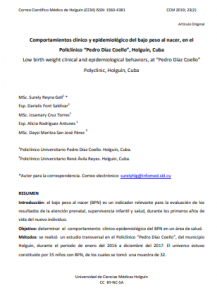
Introduction
Low birth weight is fundamental to evaluate the results of prenatal assistance, infantile survival and new-born’s wellbeing, during the first years of life.
Objective
To determine low birth weight epidemiological and clinical behaviours, in a given health area.
Method
A transversal study was carried out at “Pedro Diaz Coello” Polyclinic, Holguín, Cuba, from January 2016 to December 2017. Universe involved 35 low weight new-borns and a sample of 32. Information was obtained from obstetrics, newborn medical records and statistical graphs review of the area. Percentage was used as a summary measure.
Results
Lowest birth weight index was achieved in 2017 (3.64%). Intrauterine growth restriction (IUGR) represented 75% of the cases, 10 were preterm babies (31.25%). At birth, 56.25% neonates showed less than 37 weeks of gestational age. Pregnancy risk factors were: vaginal infection (53.13%), urinary tract infection (40.63%), anemia (37.50%), maternal undernutrition (34.38%), pregnancy hipertensive conditions (31.25%) and adolescent mothers (25%).
Conclusions
IUGR was the predominant clinical form. Other associated risk factors were: vaginal infection and urinary tract infection.